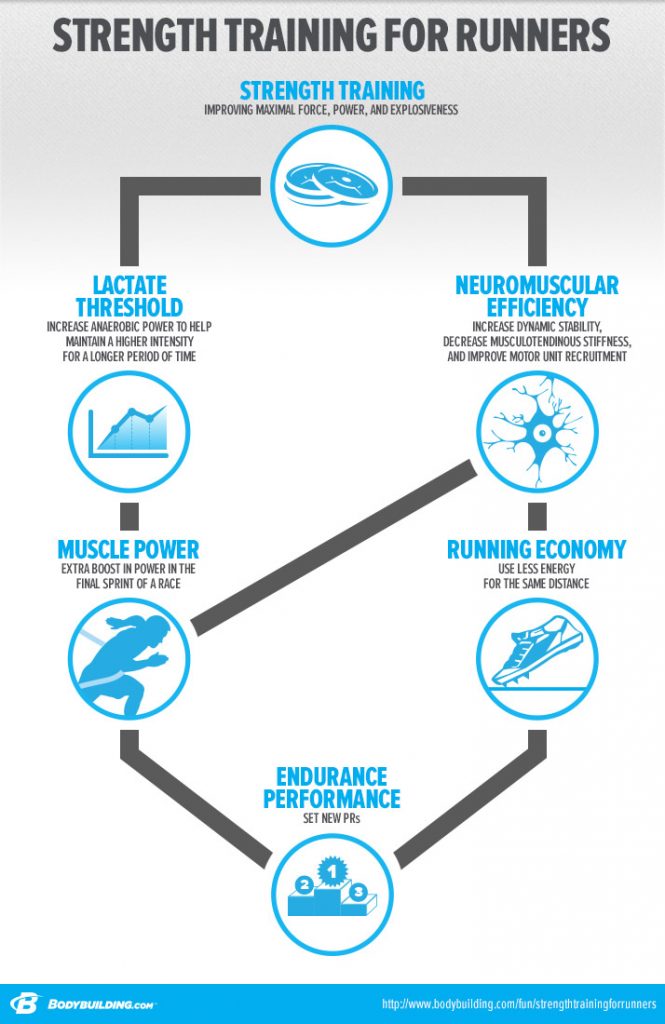Train out of your home – The trainer comes to you.
By Chicago Personal Trainer, Tia Harrison
Most runners believe that in order to perform better as a runner, which often translates to running faster, that they simply need to follow a running program or just run more often. That’s part of the puzzle, but the piece that is often missing for the majority of runners, especially distance runners, is strength training. I’ve learned from personal experience that in order to improve my finish times and run injury free, strength training is not an option, but a requirement.
Shortly after I completed my first full marathon in 2008, I decided to run a marathon in each of the 50 states by my 50th birthday. My ultimate goal was to finish each race injury free. I missed the mark in the age arena (finished my last state shortly after my 51st birthday), but I trained and ran injury free for eight years. I attribute the achievement of the latter portion of my goal to strength training. As hard as it was to fit the workouts into my busy schedule, I couldn’t relate to the benefits until I stopped strength training the year after I completed my 50th state and began training for a 50-mile ultra marathon. My ultra training plan required so much running that it was difficult for me to fit strength training into my schedule. Unfortunately I learned the hard way that a runner’s best defense against injury is a strong body! I finished the race, but I spent thousands of dollars and countless hours on physical therapy afterwards for a hip injury.
Why Should Runner’s Strength Train?
The benefits of strength training for runners—for both injury prevention and performance—are real. Whether the goal is simply to run easier with less pain or to run faster in a race, a few strength sessions every week can definitely help. Strong muscles, ligaments, and tendons guard against impact, improve form, and lead to a consistent gait. “If muscles are weak, one footfall will not be like the rest,” says Reed Ferber, Ph.D., director of the Running Injury Clinic at the University of Calgary. “How your knee turns in, your hip drops, your foot pronates changes with each step. But with strength, these movements are the same each time, so your mind and body know what to expect.”

Put a runner on a track or trail and they know what to do. Strength training isn’t as intuitive. In fact, most runners I coach have little-to-no lifting experience—meaning they are unfamiliar with exercise technique or the capabilities of their current physical and neuromuscular strength.
Here are a few questions I am often asked by runners about strength training:
“Should I do leg work, or does running work them enough?”
Most runners, both male and female, tend to do weight and resistance training for their upper-body but completely blow off lower-body weight training because they believe that running is enough to strengthen their legs. The reality is, running alone isn’t the best way to strengthen the legs. Depending on what kind of running you are doing (sprints or distance) you are either conditioning muscular strength or muscular endurance in your legs. Essentially, your body contains 2 different types of muscle fibers:
• Type I (Slow Twitch): Your body uses its slow twitch muscle fibers to run distances. Slow twitch fibers aren’t as strong as Type II fibers, but can work for extended periods of time without fatiguing.
• Type II (Fast Twitch): These are the muscle fibers you recruit when you are running sprints. They are strong and explosive, but fatigue quickly.
“Should I do upper body exercises or focus mainly on my core?
Upper body exercises actually help improve form. “They’ll build an upper musculature—arms, shoulders, chest, upper back—that will make you more athletic and improve subtler things like posture,” writes Dr. Jordan Metzl in his book—Dr. Jordan Metzl’s Workout Prescription.
“What strength exercises can I do to prevent injuries and how often should I do them?”
Most runners will get enormous benefits from 20 minutes, 3-5 times week. Below are my five favorite strength training exercises for runners. These simple strength-training exercises will help develop significant improvements in long-term performance and help prevent injury. There are other factors such as shoes, form and poor nutrition that can contribute to injuries, but that’s another blog!
A good strategy is to complete a dynamic warm-up before every run followed by a strength routine. As a mature runner, my body requires more recovery time, so I personally strength train on days when I do not run. Strength workouts should complement your running, not detract from it. If you’re so sore from strength exercises that your long run or speed training is compromised, tone down the intensity.
A Simple Strength Routine for Runners
The best strength exercises for runners have two characteristics: 1) They prevent injuries by focusing on the specific needs of runners (hip and glute strength), and 2) They are compound, multi-joint movements like squats and lunges. When the muscles are stronger, they are more resilient to fatigue which can compromise form and lead to injuries.
These five exercises are all most runner’s need and can be done just about anywhere. If you’re injury-prone, don’t have a background playing another sport, or you want to take your running to the next level, you can always do more or learn variations of these exercises. www.bodybuilding.com is a good site to check out if you need help with form and technique.
Squat
Deadlift
Lunge
Push-up
Plank
Doing something is definitely better than nothing. Incorporating strength work into your weekly schedule will reduce injury risk dramatically, allowing you to run more efficiently and race faster, — every runner’s ultimate goal.
Tia is a certified personal trainer in Chicago, IL. Contact her today to schedule a complimentary introductory session.